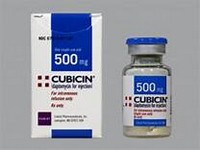Daptomycin
CLINICAL USE
Antibacterial agent
DOSE IN NORMAL RENAL FUNCTION
4–6 mg/kg once daily for 7 to 14 days depending on indication
PHARMACOKINETICS
DOSE IN RENAL IMPAIRMENT
GFR (mL/MIN)
30–50 Dose as in normal renal function<30 4 mg/kg every 48 hours
DOSE IN PATIENTS UNDERGOING RENAL REPLACEMENT THERAPIES
/VVhdFSlightly dialysed. 4–6 mg/kg every 48 hours2
IMPORTANT DRUG INTERACTIONS
Potentially hazardous interactions with other drugsWarfarin: Monitor INR when on daptomycinCiclosporin: increased risk of myopathy – try to avoid concomitant useLipid-regulating drugs: increased risk of myopathy with fibrates and statins – try to avoid concomitant use
ADMINISTRATION
Reconstition
7 mL sodium chloride 0.9% or water for injection to give a solution of 50 mg/mL
Route
IV infusion
Rate of Administration
Over 30 minutes
Comments
Once reconstituted, stable for 12 hours at room temperature and 48 hours refrigeratedAdd to 50 mL sodium chloride 0.9% before administration. Stable for 12 hours at room temperature or 24 hours refrigeratedIncompatible with dextrose solutions Compatible with solutions containing aztreonam, ceftazidime, ceftriaxone, gentamicin, fluconazole, levofloxacin, dopamine, heparin and lidocaine
OTHER INFORMATION
May cause renal impairment Vials do not contain any bacteriostatic or fungiostatic agentsCompany advises to administer post dialysisMonitor creatinine phosphokinase levels, muscle pain or weaknessIncreased risk of myopathy in severe renal failure due to increased daptomycin levels15% of dose is removed by 4 hours of haemodialysis and 11% over 48 hours by peritoneal dialysisTherapeutic concentrations of daptomycin are unlikely due to low PD clearance of drug therefore systemic use for peritonitis is unlikely to work
